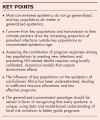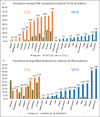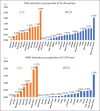Evolving HIV epidemics: the urgent need to refocus on populations with risk
- PMID: 31368909
- PMCID: PMC6688718
- DOI: 10.1097/COH.0000000000000571
Evolving HIV epidemics: the urgent need to refocus on populations with risk
Abstract
Purpose of review: To explore the comparative importance of HIV infections among key populations and their intimate partners as HIV epidemics evolve, and to review implications for guiding responses.
Recent findings: Even as concentrated epidemics evolve, new infections among current and former key population members and their intimate partners dominate new infections. Prevalent infections in the general population grow primarily because of key population turnover and infections among their intimate partners. In generalized epidemic settings, data and analysis on key populations are often inadequate to assess the impact of key population-focused responses, so they remain limited in coverage and under resourced. Models must incorporate downstream infections in comparing impacts of alternative responses.
Summary: Recognize that every epidemic is unique, moving beyond the overly simplistic concentrated/generalized epidemic paradigm that can misdirect resources. Guide HIV responses by gathering and using locally relevant data, understanding risk heterogeneity, and applying modeling at both national and sub-national levels to optimize resource allocations among different populations for greatest impact. Translate this improved understanding into clear, unequivocal advice for policymakers on where to focus for impact, breaking them free of the generalized/concentrated paradigm limiting their thinking and affecting their decisions.
Figures








References
-
- UNAIDS/WHO Working Group on Global HIV/AIDS and STI Surveillance. Guidelines for second generation HIV surveillance. Geneva: UNAIDS/WHO; 2000.
-
- UNAIDS. Practical guidelines for intensifying HIV prevention: towards universal access. Geneva: Joint United National Programme on HIV/AIDS; 2007.
-
- Stover J, Walker N, Garnett GP, et al. Can we reverse the HIV/AIDS pandemic with an expanded response? Lancet 2002; 360:73–77. - PubMed
-
- Ainsworth M, Teokul W. Breaking the silence: setting realistic priorities for AIDS control in less-developed countries. Lancet 2000; 356:55–60. - PubMed
Publication types
MeSH terms
LinkOut - more resources
Full Text Sources
Medical
Research Materials

